Northern Vietnamese Cuisine – The Quintessence of Vietnamese Culture
Cuisine is a natural cultural feature formed in life, when mentioning Northern Vietnamese cuisine, it is not difficult to recognize the light, delicate flavor and extremely sophisticated decoration. In this article, Vietnam Motorbike Tours Club will introduce to you the culinary features of Northern Vietnam. From rustic dishes, processing and decoration methods, to flavors, so that you can better understand the rich cuisine of Northern Vietnam. Vietnam Motorbike Tours Club is committed to providing you with the most accurate and useful information that is not available anywhere else.
Characteristics of northern Vietnamese cuisine
Northern Vietnamese cuisine has long been known for its sophistication and harmony, imbued with the cultural identity of the Northern Delta. To better understand the unique features of Northern cuisine, we will explore the way of seasoning, the sophistication of flavors and the richness and diversity of this unique cuisine:
Northern cuisine does not use too many spices
Northern cuisine has a distinctive style with elegance and gentleness in the way of seasoning, creating a difference compared to the Central and Southern regions. The dishes here are not too spicy, not too sweet or greasy, but focus on highlighting the natural flavors of the ingredients. Northerners prefer sophistication and balance, demonstrated through the use of diluted fish sauce, moderate shrimp paste along with green vegetables and freshwater seafood such as shrimp, crab, fish, mussels, and clams. In particular, choosing fresh ingredients and simple processing to preserve the natural sweetness is a top priority, creating the unique appeal of the cuisine of this land.
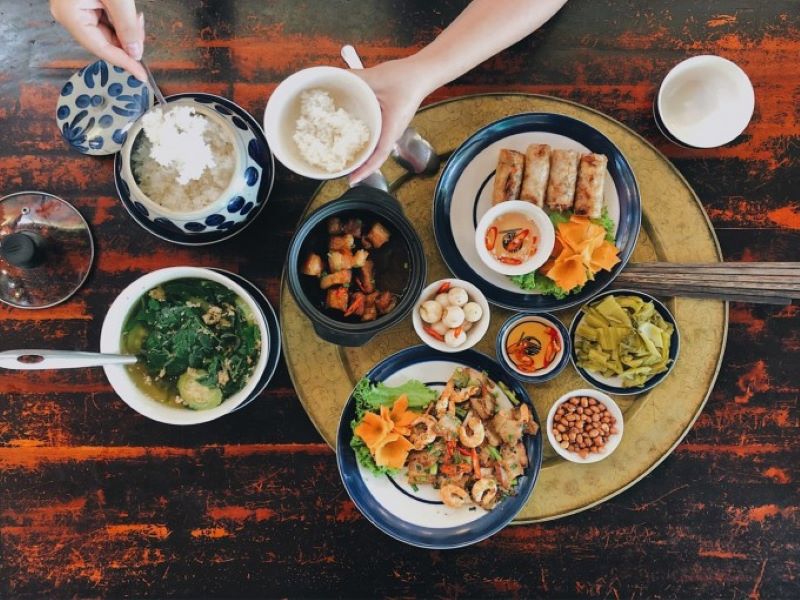
Northerners prefer sophistication and balance
In addition, Northern cuisine also reflects the traditional culture associated with the ancient agriculture, when people’s lives were still difficult and dishes mainly relied on easy-to-find ingredients. Meat and fish were not the main ingredients in daily meals, instead vegetables and seafood from the river regions were popular. However, although simple, Northern dishes still have an elegant beauty through presentation and harmonious colors. Typical dishes such as pho, bun cha, and La Vong fish cakes not only imbued with the spirit of simplicity but also the pride of the Northern people, leaving a strong impression on domestic and foreign diners.
Rich in flavor but no less simple
Northern cuisine stands out for its harmony, sophistication and ingenuity in both preparation and presentation. Dishes often have a light, bland taste, with a slight sourness from natural ingredients such as star fruit, lemon or vinegar, especially suitable for hot summer days. Not inclined to spicy, sweet or fatty flavors like the South and Central regions, Northern cuisine often uses diluted fish sauce or shrimp paste as the main seasoning. The color of the dish is also a highlight, often bright and eye-catching, showing the sophistication in the combination of ingredients.
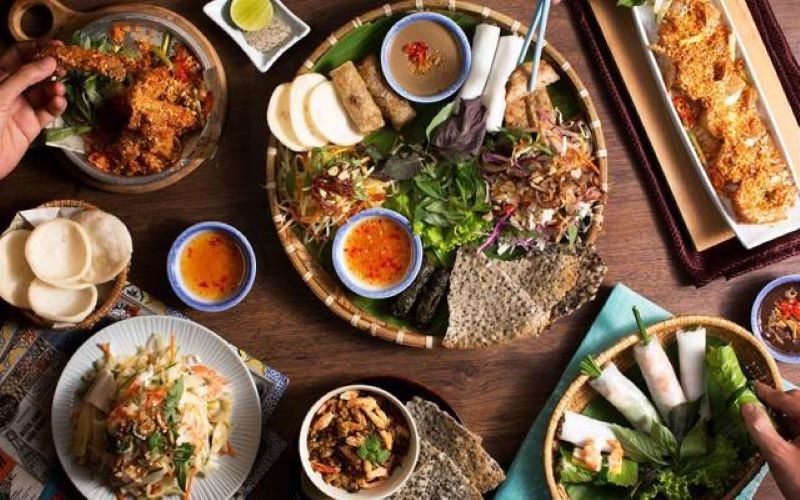
Sophistication and ingenuity in both preparation and presentation
On holidays, the ingenuity and sophistication of Northern people are more clearly demonstrated through the image of traditional trays. The “high trays and full dishes” are often elaborately arranged, with the standard of “four bowls and six plates”, including dishes that are elaborately prepared in both form and flavor. This is not only a cultural symbol but also a demonstration of respect for ancestors and pride in the culinary art of this land.
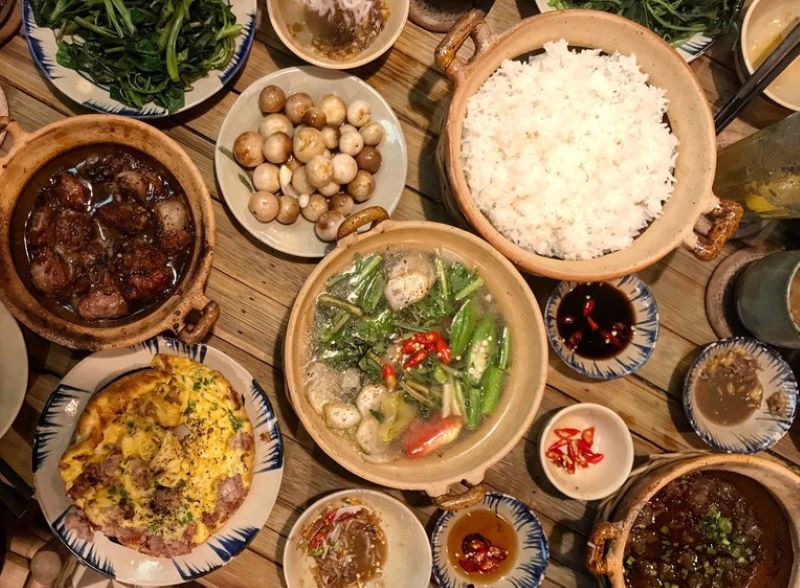
The “high trays and full dishes” are often elaborately arranged
In addition, the dining culture of the Northern people also reflects the sophistication and standards of behavior. Proverbs such as “Eat and watch the pot, sit and watch the direction” or “A greeting is more important than a feast” emphasize respect and politeness in every meal. Northern people value order and etiquette when eating, often inviting the elderly or respected people to eat first. Tact is also shown through the way of inviting, picking up food and caring for each other during meals.
Rich and diverse cuisine
Hanoi has long been considered a place where the quintessence of Northern cuisine converges, featuring famous dishes associated with the culture of the Northern Delta. Names such as pho, bun cha, bun oc, bun thang, xoi com Vong, and Thanh Tri rolled rice cakes not only make Hanoi cuisine famous but also conquer domestic and foreign diners with their unique flavors and sophisticated preparation methods. Special spices such as belostomatid essential oil, shrimp paste, or Lang basil further highlight the unique, unmistakable features of the cuisine here.
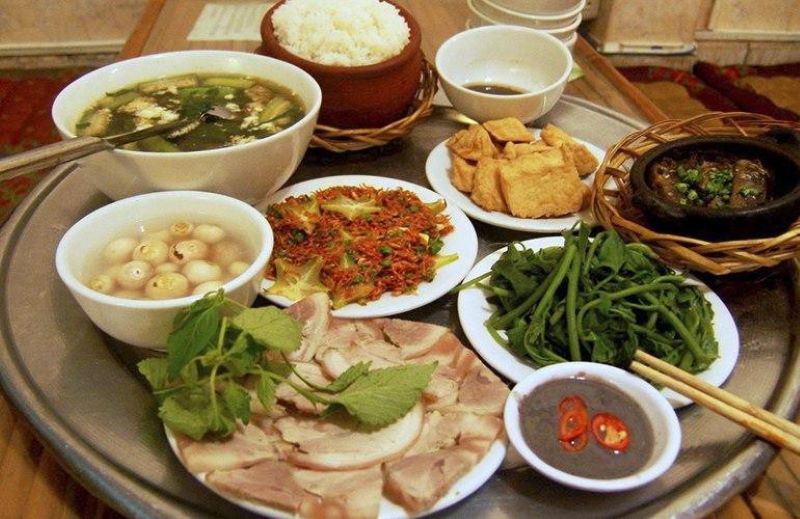
Special spices such as belostomatid essential oil, shrimp paste,…
Not only stopping in Hanoi, Northern cuisine is also embellished by specialties from other regions, each with its own unique mark. Specialties such as Chiem Hoa field fish sauce, Ha Giang mountain mint honey, delicious field snails, Doan Hung grapefruit, Thanh Son sour meat, Viet Tri dog meat, or Hoanh Bo soaked sticky rice wine all bear the distinct regional identity. In particular, Ha Long is famous for unique dishes such as mackerel braised in fresh tea water or sea worms – considered “sea gold” because of its nutritional value and excellent flavor.
Dishes with typical flavors of Northern Vietnamese cuisine
Northern cuisine is expressed through dishes with a light, delicate taste and sophisticated and elaborate decoration. Join Vietnam Motorbike Tours Club to discover delicious dishes of the North and their unique cooking methods:
La Vong Fish Cake – Hanoi
During the French colonial period, at 14 Hang Son, there was a Doan family living and often sheltering the De Tham insurgents. This family had a special delicious fish cake dish that they often made to entertain visitors. Gradually, the dish became famous, and their regular guests advised them to open a small restaurant, both to make a living and as a gathering place. The fish cake restaurant was not only famous for its unique flavor but also associated with the spirit of solidarity of the people during difficult times.

The fish cake restaurant was not only famous for its unique flavor
In the restaurant, the image of Mr. La Vong (Khuong Tu Nha) fishing was placed solemnly as a symbol. Mr. La Vong was known as a talented person but had to wait for the right time, showing the patience and aspiration of the Doan family during difficult years. Therefore, customers coming to the restaurant have become accustomed to calling this dish “La Vong fish cake”. The name is not only a symbol of the restaurant but also closely associated with the spirit and culinary culture of Hanoians, becoming an indispensable part of the history and culinary life here.
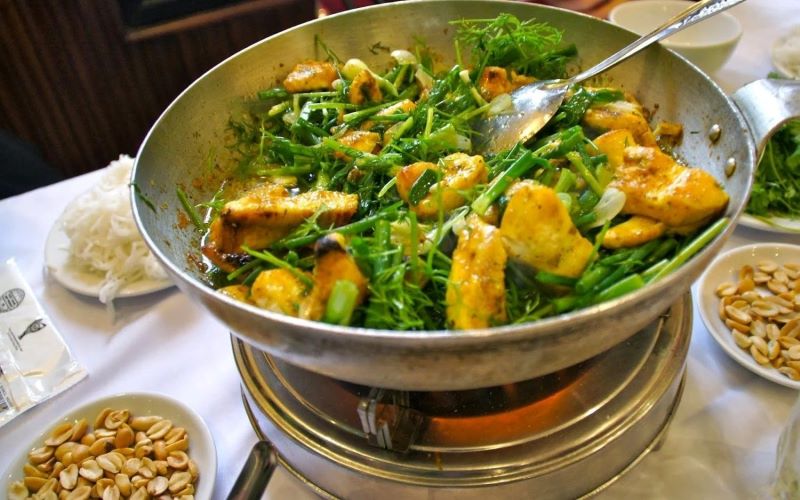
The main ingredient is fresh catfish – a fish with few bones
La Vong fish cake stands out for its incomparable flavor, thanks to the elaborate preparation and family secrets that are only passed down to the descendants in the family. The main ingredient is fresh catfish – a fish with few bones, sweet meat and a special aroma. After being pre-processed, the fish will be marinated with rich spices, grilled over charcoal to create a fragrant aroma and then fried again in a pan of oil. The dish is often enjoyed with vermicelli, roasted peanuts, herbs and shrimp paste mixed with lemon and chili, creating a perfect blend.
Green bean cake – Hai Duong
Born in the early 20th century, green bean cake has quickly become a typical symbol of Hai Duong. Not fussy about ingredients or making methods, green bean cake exudes a simple, rustic look but is rich in the flavor of the Northern countryside. The cake is made from fine green bean flour, mixed with fat and sugar, creating a sweet, fatty taste and an unforgettable characteristic aroma. Each piece of cake seems to encapsulate the love of the homeland and the skill of the baker, bringing a feeling of closeness and familiarity in each flavor.
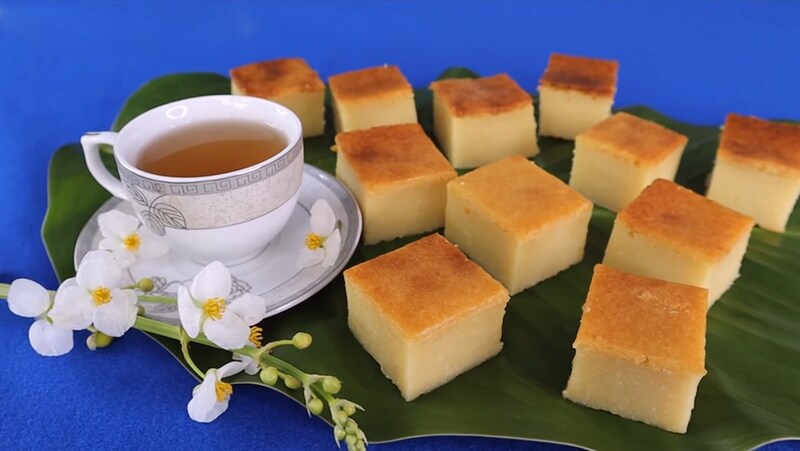
The cake is made from fine green bean flour
The best way to enjoy green bean cake is with a cup of hot tea. The sweet and fatty taste of the cake combined with the slight astringency and bitterness of the tea not only increases the appeal of the cake but also creates a sophisticated culinary experience, typical of Vietnamese culture. Just take a bite of cake, sip a sip of tea, you will feel the perfect harmony, the sweet taste and gentle aroma spreading throughout the taste buds. Nowadays, Hai Duong green bean cake has become a famous brand throughout the country, a specialty gift that anyone visiting this land wants to bring back.
Braised fish from Vu Dai village – Ha Nam
When mentioning famous Vietnamese specialties, we cannot ignore Vu Dai braised fish – a culinary quintessence associated with the Northern countryside. This dish originated from Vu Dai village (now Nhan Hau village, Hoa Hau commune, Ly Nhan district, Ha Nam province), a fertile lowland plain and natural fish ponds. Since ancient times, fish has become a familiar dish, especially during the Tet holiday. About a few decades ago, the people here created a unique way to braise fish for long-term preservation, helping the dish to always retain its rich flavor throughout the month.
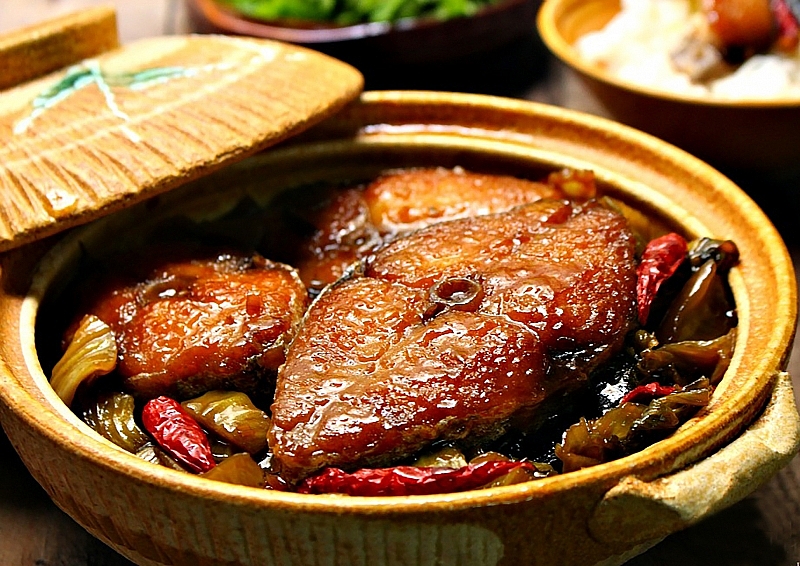
This dish originated from Vu Dai village
Vu Dai braised fish is made from black carp – a type of fish with firm and delicious meat – according to a traditional recipe, braised in a clay pot for 16-24 hours. A layer of galangal is placed at the bottom of the pot to remove the fishy smell and prevent the fish from burning when braised for a long time, adding a special flavor to the dish. The finished product is dark brown fish pieces, soft meat, bones that melt in the mouth, each piece of fish is soaked in spices, creating an unforgettable flavor. Not only a specialty of Ha Nam, Vu Dai braised fish is also popular on the dinner table of families in Northern Vietnam.
Com Lang Vong
The ancients used to praise: “Vong green rice, Me Tri fragrant rice; Tuong Ban, Lang basil, what could be more delicious?”, and indeed, Vong village green rice has become a quintessential symbol of Hanoi cuisine. Made from the yellow-flowered sticky rice variety, Vong green rice must be flat, young green, and have the elegant flavor of rice that has just passed the milking stage. The time to harvest rice to make green rice is extremely important, usually when the rice flowers turn light yellow, only about ten days before harvest. If the rice is cut too old, the green rice grains will be hard, brittle, and lose their natural green color; if the rice is too young, the green rice will be sticky, mushy, and will not retain its characteristic delicious flavor.
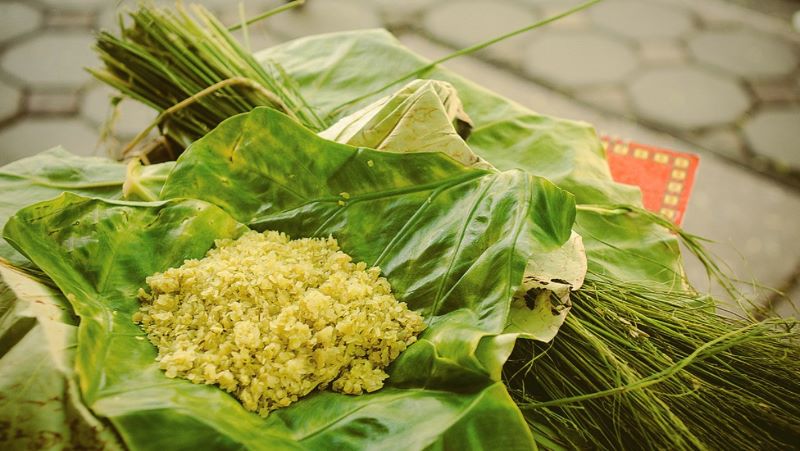
The time to harvest rice to make green rice is extremely important
The process of making Vong village green rice requires meticulousness and skill, especially in the roasting and pounding stages. The rice is roasted over medium heat, so that the green rice grains are just cooked, not brittle, but the husk must be removed. The pounding process must also be done gently and evenly in separate mortars to create smooth and supple rice grains with a clear green color. The finished rice is carefully wrapped in old lotus leaves, both to retain moisture and to infuse the faint scent of lotus. Enjoying rice is an art: do not use a bowl or spoon, but pick up small handfuls in lotus leaves, chew slowly to feel the sweet taste of young sticky rice mixed with the fragrant scent of lotus.
Bun Cha
As one of the oldest dishes and bearing the cultural imprint of Hanoi, bun cha has long become a famous specialty not only for the capital’s people but also for tourists from all over the world. To make a standard bun cha dish, the vermicelli must meet the standards of being chewy, soft, white and having a characteristic aroma. This type of vermicelli is often taken from Phu Do craft village – a place famous for its long-standing tradition of making vermicelli. When combined with the rich flavor of grilled meat, vermicelli will create a unique blend that is difficult for any other dish to match.
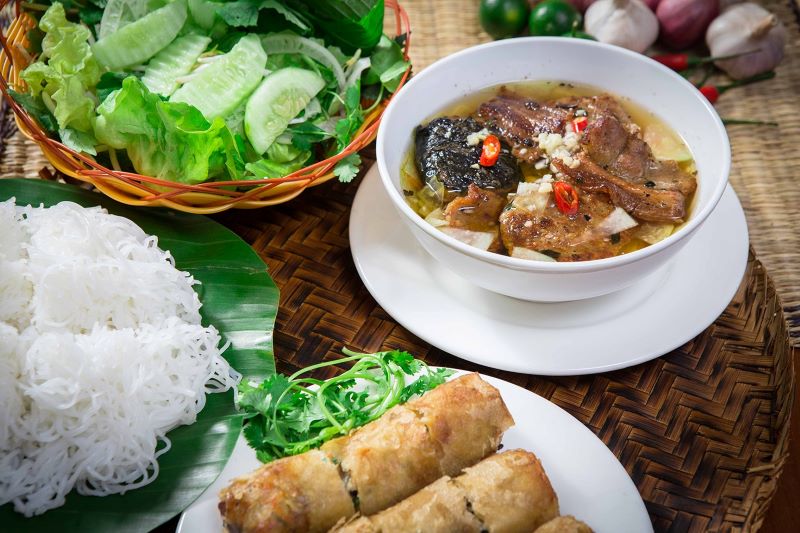
This type of vermicelli is often taken from Phu Do craft village
The meat used for the dish can be meatballs or pieces of meat, but the common point is that it must be carefully marinated with the right spices, then grilled on a charcoal stove to create a strong aroma and a crispy golden outer layer. When eaten, the meatloaf is served with a delicately prepared sweet and sour fish sauce and herbs such as perilla and lettuce. This combination not only highlights the characteristic flavor of bun cha but also gives diners a cool, harmonious feeling, a perfect representative of the culinary quintessence of Hanoi.
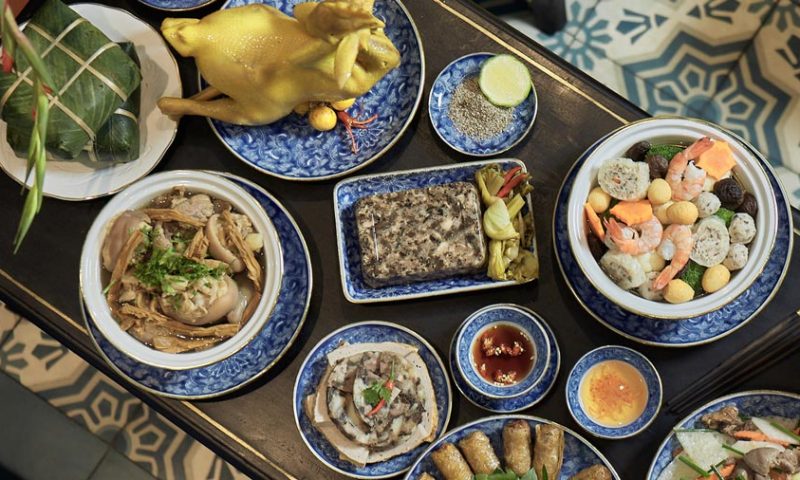
Northern Vietnamese cuisine is very diverse but also sophisticated
Above are just some of the outstanding dishes of northern Vietnamese cuisine. In addition, there are many other delicious dishes, with unique flavors, preparation methods, and ways of enjoying. Northern Vietnamese cuisine is very diverse but also sophisticated, let’s visit Vietnam to enjoy these dishes.
To make your trip more complete, safe and enjoyable, you should choose Vietnam Motorbike Tours Club as your tour organizer. We are proud to be the number one travel company in Vietnam, specializing in providing the best services. With a team of experienced experts and deep understanding of this land, Vietnam Motorbike Tours Club is committed to bringing you memorable experiences and the best services that no other unit can bring to you. Visit the website https://vietnammotorbiketoursclub.com/ or contact the phone number 0976 024 986 so that our team of experts can advise and answer all your questions.
Contact us for more interesting information
- Address: 3/7/36 Duy Tan Street, Cau Giay District, Ha Noi City
- Mobile: +84 976 024 986
- Email: [email protected]
- Website: https://vietnammotorbiketoursclub.com/
RELATED POSTS
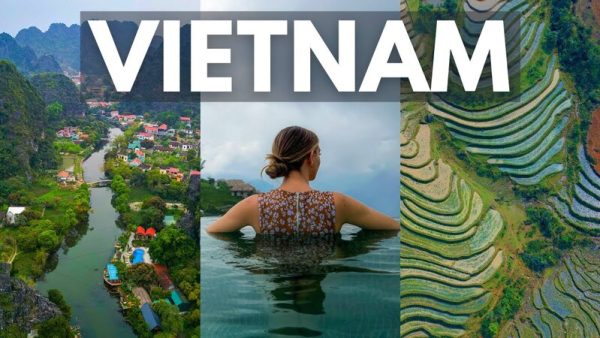
Visiting Vietnam In March 2025? Top 10 Hottest Destinations
March is an ideal time to travel, with pleasant weather and fresh air, leaving many wondering which destination to choose. If you are also looking...
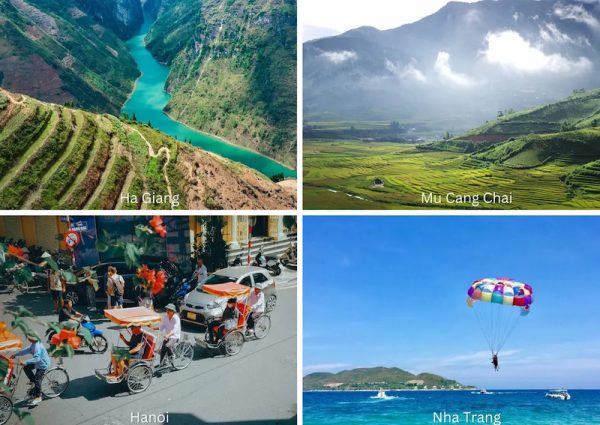
The Ultimate Guide to Visiting Vietnam In April 2025
April is a unique transitional period in Vietnam, bringing a pleasant atmosphere that is perfect for travel. It’s when the country blends the lingering coolness...

Ghenh Da Dia Phu Yen – A beautiful check-in location for tourists
Ghenh Da Dia Phu Yen – a unique natural wonder of Vietnam, where basalt rocks are stacked like giant honeycombs creating a magnificent picture in...




